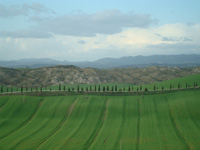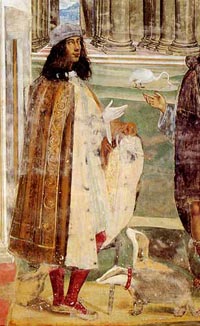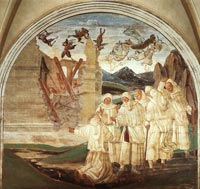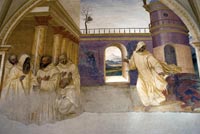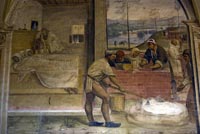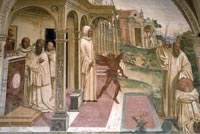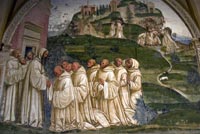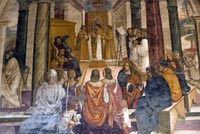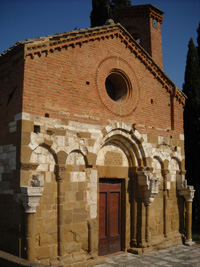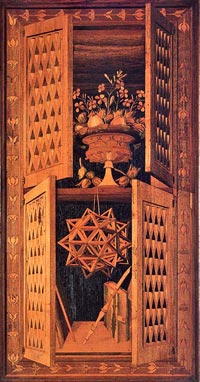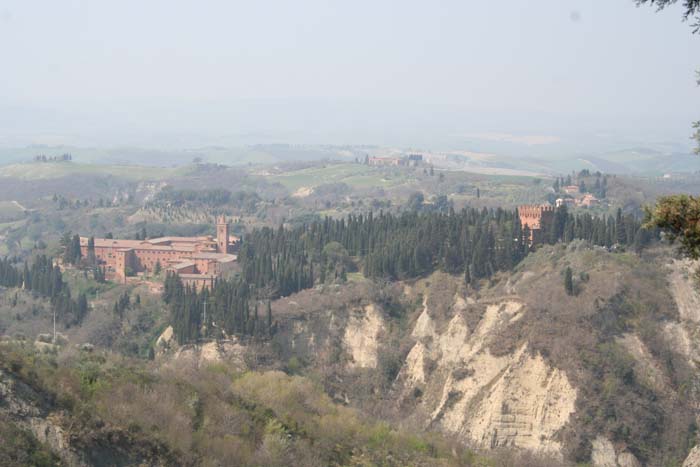 |
|
| N L | Abbazia di Monte Oliveto Maggiore |
Abbazia di Monte Oliveto Maggiore |
The Crete Senesi refers to an area of the Italian region of Tuscany to the south of Siena. It consists of a range of hills and woods among villages and includes the comuni of Asciano, Buonconvento, Monteroni d'Arbia, Rapolano Terme and San Giovanni d'Asso. Crete senesi are literally ‘Sienese clays’ and the distinctive grey colouration of the soil gives the landscape an appearance often described as lunar. This characteristic clay is known as mattaione.Asciano is a medieval town center and has several interesting churches and museums. Five miles south of Asciano, the atmospheric complex of the Abbazia di Monte Oliveto Maggiore, which was founded in 1313 by Giovanni Tolomei, dominates the landscape of the Crete. It is located on a hilltop, immersed in a dark yet beautiful natural landscape, and is marked by a suggestive, mystical history. It is the mother-house of the Olivetans and the monastery later took the name of Monte Oliveto Maggiore (the greater) to distinguish it from successive foundations at Florence, San Gimignano, Naples and elsewhere. The abbey's origins date back to the middle ages. Abbazia di Monte Oliveto Maggiore was founded in 1313 by Bernardo Tolomei. An imposing square tower with a drawbridge that was part of the original defences erected to protect the entire complex stands at the entrance to the Abbey. The courtyard of the abbey opens onto a broad avenue of cypresses. To the left is the botanical garden that supplied medicinal plants for the monks. A little further on is the fish pond designed in 1553 by Pelori and used by the monks to provide fish at those times of year during which the Benedictine rule forbade the consumption of meat. The cypress avenue leads to the impressively austere, late-gothic church of the abbey, built between 1399 and 1417. The interior of the abbey, renovated in Baroque style, houses a number of precious works of art, including an engraved wooden choir. In the magnificent rectangular Chiostro Grande, constructed between 1426 and 1443. It is made up of two passages, one above the other, supported by columns. The portico is decorated with a fresco cycle by Luca Signorelli depicting the life of St Benedict, who began work on its 36 large scenes in 1497. Signorelli painted eight frescoes. The two last frescoes of the Monte Oliveto series indicate that an immense force lay in reserve, waiting an opportunity for some wider and freer field of action, than had hitherto presented itself. That opportunity came, when, at the age of fifty-nine, he was called upon to undertake the vast work of his Orvieto frescoes. [read more] The cycle was finished in 1508 by Sodoma. Il Sodoma painted in a manner that superimposed the High Renaissance style of early 16th-century Rome onto the traditions of the provincial Sienese school. He spent the bulk of his professional life in Siena, with two periods in Rome. |
||
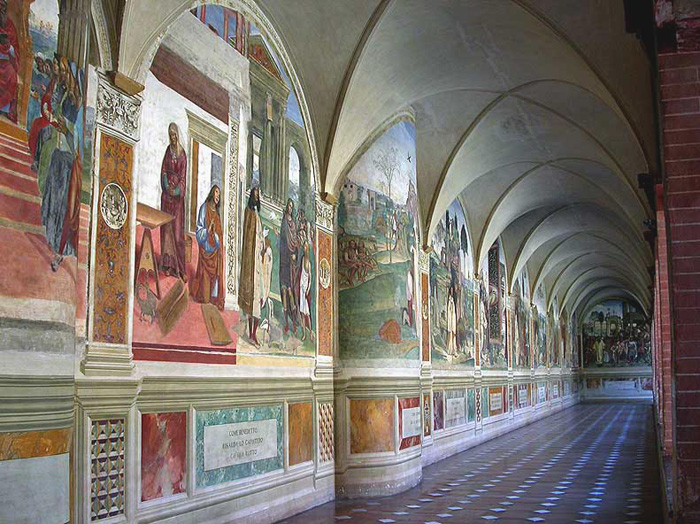 |
||
Monte Oliveto Maggiore, Chiostro Grande |
||
The Chiostro Centrale is composed of a portico that leads to the magnificent Refectory, decorated with frescoes by Fra’ Paolo Novelli. |
||
| Luca Signorelli, frescoes in the Abbazia di Monte Oliveto Maggiore |
||
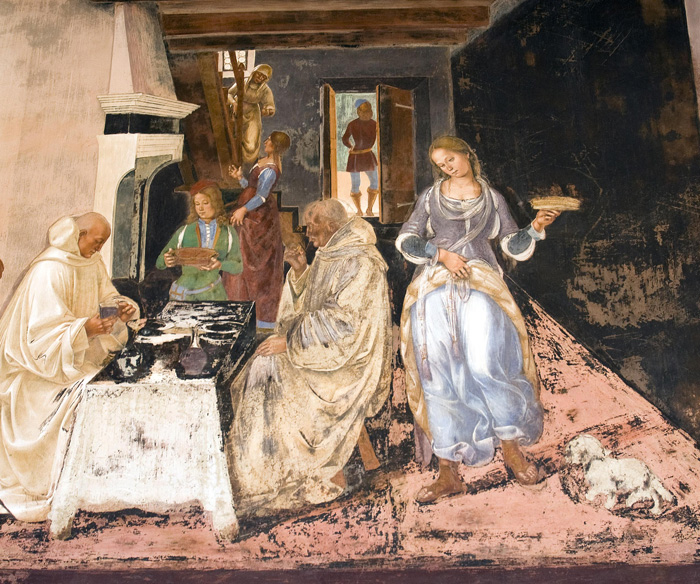 |
||
Luca Signorelli, Come Benedetto dice alli monaci dove e quando avevano mangiato fuori dal monastero (dettaglio), Abbey of Monte Oliveto Maggiore |
||
| Luca Signorelli was an Italian painter from Cortona, active in various cities of central Italy, notably Arezzo, Florence, Orvieto, Perugia, and Rome. According to Vasari, Signorelli was a pupil of Piero della Francesca. He must have had a considerable reputation by about 1483, when he was called on to complete the cycle of frescoes on the walls of the Sistine Chapel in Rome, left unfinished by Botticelli, Ghirlandaio, Perugino, and Rosselli. Signorelli worked in Rome until 1484 when he returned to his native Cortona, which remained from this time his home. In the Monastery of Monte Oliveto Maggiore (Siena) he painted eight frescoes, forming part of a vast series of the life of St Benedict. From the Monastery of Monte Oliveto Maggiore went to Orvieto, where he painted a magnificent series of six frescoes illustrating the end of the world and the Last Judgement (1499-1504). The life of St Benedict is considered as a reflection and ideal of the monastic life. The exemplary nature of the scenes presented in the cloister at Monteoliveto Maggiore gives the impression that they were deliberately selected for their bearing on life within the monastery. Virtually all of the community's activities and concerns are reflected in them. The ultimate textual source for the Benedict cycle was the biography written by Gregory the Great in about 593-94, which tells the story of the important monastic founder in thirty-eight chapter. The cycle was finished in 1508 by Sodoma. Il Sodoma painted in a manner that superimposed the High Renaissance style of early 16th-century Rome onto the traditions of the provincial Sienese school. He spent the bulk of his professional life in Siena, with two periods in Rome. |
||
| Il Sodoma, frescoes in the Abbazia di Monte Oliveto Maggiore |
||
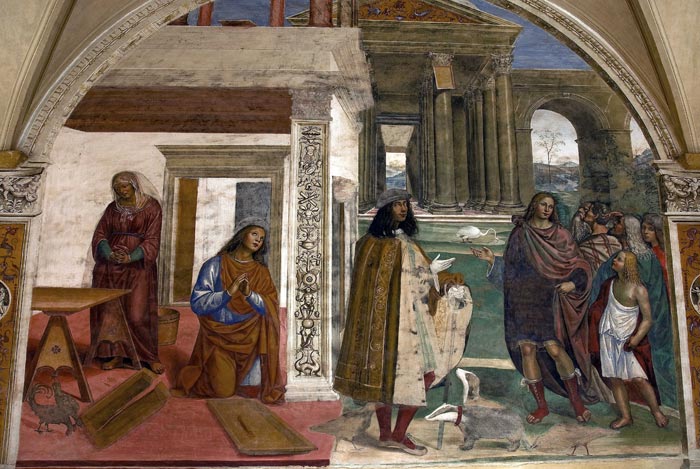 |
||
Il Sodoma, Benedict Repairs a Broken Colander through Prayer, with selfportrait of the artist, Monastery of Monte Oliveto Maggiore |
||
Il Sodoma (1477 – February 14, 1549) was the name given to the Italian Renaissance painter Giovanni Antonio Bazzi.[1] Il Sodoma painted in a manner that superimposed the High Renaissance style of early 16th-century Rome onto the traditions of the provincial Sienese school; he spent the bulk of his professional life in Siena, with two periods in Rome.
|
||
| Leaving Monte Oliveto Maggiore and passing through San Giovanni d'Asso the route comes to Trequanda. A perfectly preserved 13th-century castle dominates the few houses that there are with its cylindrical crenellated tower. The church in the main Square, dedicated to Saints Peter and Andrew, is also 13th century and has a unique black and white stone checkerboard facade. Inside, there is a wonderful fresco of the Transfiguration by Sodoma. |
||
The festival Accademia delle Crete Senesi was founded on the initiative of artistic director Philippe Herreweghe and some musicians of the Orchestre des Champs Elysées. The Accademia aims to give young talents a chance to play with experienced musicians. The concerts of the Accademia delle Crete take place in small but marvellous churches, chosen because of their adequate acoustics for the repertoire on the program. The Crete Senesi offers splendid locations: Asciano, Castelmuzio, Pienza, Sant’Anna in Camprena, San Quirico d’Orcia... |
||
| The small town of Asciano, in the heart of the Crete, still has many of its old medieval palaces and various towers, including the guard towers of the outer walls, which now lie inside the modern-day town. Asciano has many unusual mixed Romanesque and Gothic architectural forms which are of considerable interest. [read more] |
||
| Buonconvento is an ancient settlement in the more gentle side of Siena area. The first residential settlements in the area of Buonconvento probably go back to the Etruscan and Roman Ages. Despite this historical data about the foundation of the village, its development starts on the 12th century, when the village already had a great importance as a place where the trading activities took place, promoted this latter by the closeness to the two rivers and to its position on the Via Francigena, one of Europe's major routes in the Middle Ages. The Museo della Val d’Arbia (Val d’Arbia Museum) has recently been opened in the centre o. Here, visitors will find works of art by Sano di Pietro and Matteo di Giovanni. Other sites of interest in the town include the Museo di Arte Sacra (the Museum of Sacred Art), Palazzo Ricci, the church of San Pietro e Paolo (Saint Peter and Saint Paul) and the Oratorio di San Sebastiano (the Oratory of Saint Sebastian). [read more] |
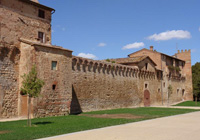 Buonconvento |
|
| San Giovanni d'Asso is a comune, located 30 km southeast of Siena in the Crete Senesi, about 8 km south-eastwards from Buonconvento. The place name comes from a church that was fouded and entitled to Sain John Baptist (San Giovanni d'Asso is like Saint John of Asso). Later the specification Asso was added, with reference to the torrent along which the village rises. The hamlet is overlooked by large Castle, now home to the tartufo museum. Also interesting in the historical centre are the churches of San Giovanni Battista (pieve) and San Pietro in Villore, both of medieval origin. Among the numerous celebrations periodically taking place in San Giovanni d'Asso we remind the "Exhibit of the White Truffle" held yearly on November. [read more] |
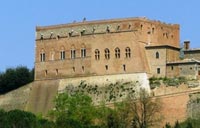 San Giovanni d'Asso |
|
| Photo gallery Monte Oliveto Maggiore |
|
|||
 |
 |
|||
Monte Oliveto Maggiore [1]
|
Monte Oliveto Maggiore [1] | Monte Oliveto Maggiore, Campanile[3] |
||
|
||||
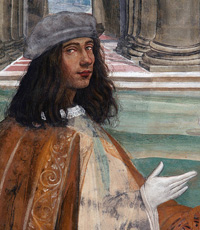 |
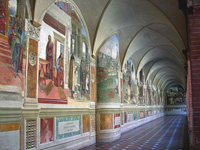 |
 |
||
| Fattoria Abbazia di Monteoliveto |
||||
| The estate, located 1km from the town, and now property of the Zonin family, is dominated by the historic Abbazia Monte Oliveto, which was built by Olivetan monks in 1340. The land around the abbey includes 18 hectares (37 acres) of vineyards, all planted in Vernaccia of San Gimignano. The wine made from that variety was already famous in the lifetime of Dante Alighieri. Wines: Vernaccia di San Gimignano, Fusaia Sangiovese IGT and Vino Rosso IGT Toscana. |
|
|||
Walking in the Crete Senesi Near the abbey, you can make some beautiful walks. This is one of the most beautiful regions of Tuscany and the hills with cypresses and isolated buildings in the countryside seem to have been plucked from a medieval painting by Ambrogio Lorenzetti in the Palazzo Publico.
|
||||
|
||||
The most beautiful walks in the Crete senesi, near Monte Oliveto Maggiore
|
||||
Podere Santa Pia, a formerl cloister in the Tuscan Maremma is situated on the outskirts of Castiglioncello Bandini, and dominates one of the most beautiful setting that nature can offer: the Tuscan countryside. The most interesting artistic, historical and cultural sites of southern Tuscany are nearby, and are awaiting your discovery.
|
||||
| [1] Intarsia are mosaics made of pieces of inlaid wood. They are a remarkable art form which reached a peak in northern Italy in the late 15th and early 16th centuries. Intarsia is a form of wood inlaying that is similar to marquetry. The term is also used for a similar technique used with small, highly polished stones set in a marble matrix. The technique of intarsia inlays sections of wood (at times with contrasting ivory or bone, or mother-of-pearl) within the solid stone matrix of floors and walls or of table tops and other furniture; by contrast marquetry assembles a pattern out of veneers glued upon the carcase. It is thought that the word 'intarsia' is derived from the Latin word 'interserere' which means "to insert". Domenico di Nicolo, one of the finest Sienese masters of intarsia and carving, worked for 13 years on the chapel in the Palazzo Pubblico at Siena, using some of Taddeo Bartoli's designs. Intarsia was originally made by sinking forms into wood, following a prearranged design, and then filling in the hollows with pieces of different coloured woods. Initially only a small number of colours were used. Early writings indicate that the only tints employed were black and white, but this must be interpreted broadly. The colour of wood on the same plank usually differs from place to place; tinting would not have obscured the variations in wood colour. In the early fifteenth century, at the beginning of the Italian Renaissance, the intarsiatori produced graceful arabesque works perfectly suited to the raw material and often executed with perfection. These works are considered by some to be the most entirely satisfactory of their works, although not necessarily the most marvellous. After the invention of perspective drawing and its application to painting, ambitious intarsia crafters emulated this representational trend in wood. Much of their work focussed on street scenes and architectural subjects (not always very successfully) and simple objects like cupboards with their doors partly open to show items on the shelves (often extraordinarily realistic considering the materials and techniques used). This focus on realism was assisted by Fra Giovanni da Verona's discovery of acid solutions and stains for treating wood (to produce a greater variety of colours) and by the practice of scorching areas of the wood to shade them, suggesting roundness. [2] Web Gallery of Art | www.wga.hu |
||||
|
||||

